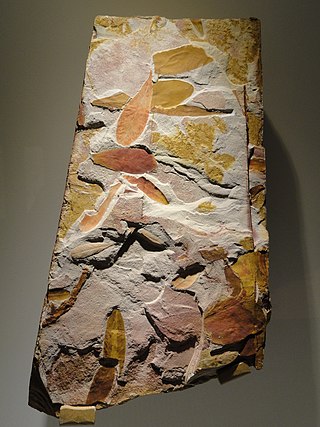
Glossopteris is the largest and best-known genus of the extinct Permian order of seed plants known as Glossopteridales. The genus Glossopteris refers only to leaves, within a framework of form genera used in paleobotany. Species of Glossopteris were the dominant trees of the middle to high-latitude lowland vegetation across the supercontinent Gondwana during the Permian Period. Glossopteris fossils were critical in recognizing former connections between the various fragments of Gondwana: South America, Africa, India, Australia, New Zealand, and Antarctica.
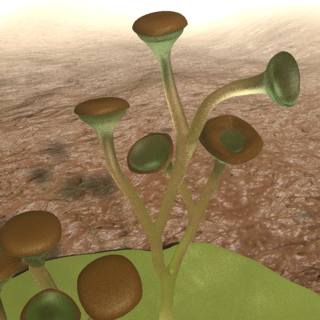
Cooksonia is an extinct group of primitive land plants, treated as a genus, although probably not monophyletic. The earliest Cooksonia date from the middle of the Silurian ; the group continued to be an important component of the flora until the end of the Early Devonian, a total time span of 433 to 393 million years ago. While Cooksonia fossils are distributed globally, most type specimens come from Britain, where they were first discovered in 1937. Cooksonia includes the oldest known plant to have a stem with vascular tissue and is thus a transitional form between the primitive non-vascular bryophytes and the vascular plants.
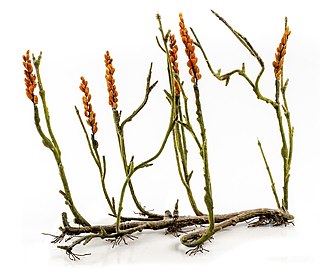
The zosterophylls are a group of extinct land plants that first appeared in the Silurian period. The taxon was first established by Banks in 1968 as the subdivision Zosterophyllophytina; they have since also been treated as the division Zosterophyllophyta or Zosterophyta and the class or plesion Zosterophyllopsida or Zosteropsida. They were among the first vascular plants in the fossil record, and had a world-wide distribution. They were probably stem-group lycophytes, forming a sister group to the ancestors of the living lycophytes. By the late Silurian a diverse assemblage of species existed, examples of which have been found fossilised in what is now Bathurst Island in Arctic Canada.
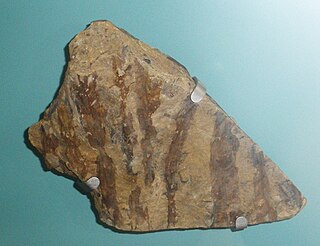
Drepanophycus is a genus of extinct plants of the division Lycopodiophyta of Early to Late Devonian age, found in Eastern Canada and Northeast US, China, Russia, Egypt and various parts of Northern Europe and Britain.

Asteroxylon is an extinct genus of vascular plants of the Division Lycopodiophyta known from anatomically preserved specimens described from the famous Early Devonian Rhynie chert and Windyfield chert in Aberdeenshire, Scotland. Asteroxylon is considered a basal member of the Lycopsida.
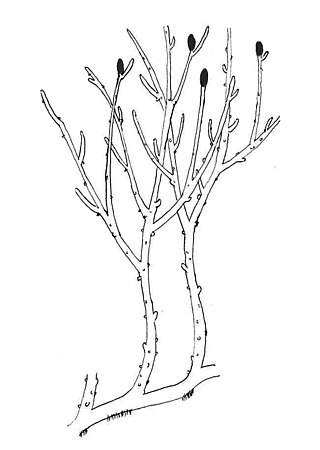
The rhyniophytes are a group of extinct early vascular plants that are considered to be similar to the genus Rhynia, found in the Early Devonian. Sources vary in the name and rank used for this group, some treating it as the class Rhyniopsida, others as the subdivision Rhyniophytina or the division Rhyniophyta. The first definition of the group, under the name Rhyniophytina, was by Banks, since when there have been many redefinitions, including by Banks himself. "As a result, the Rhyniophytina have slowly dissolved into a heterogeneous collection of plants ... the group contains only one species on which all authors agree: the type species Rhynia gwynne-vaughanii". When defined very broadly, the group consists of plants with dichotomously branched, naked aerial axes ("stems") with terminal spore-bearing structures (sporangia). The rhyniophytes are considered to be stem group tracheophytes.
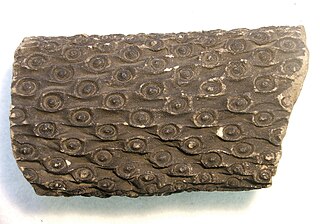
Stigmaria is a form taxon for common fossils found in Carboniferous rocks. They represent the underground rooting structures of arborescent lycophytes such as Sigillaria and Lepidodendron under the order Lepidodendrales.

Prototaxites is an extinct genus of terrestrial fossil fungi dating from the Late Silurian until the Late Devonian periods. Prototaxites formed large trunk-like structures up to 1 metre (3 ft) wide, reaching 8 metres (26 ft) in length, made up of interwoven tubes around 50 micrometres (0.0020 in) in diameter, making it by far the largest land-dwelling organism of its time.

Nematothallus is a form genus comprising cuticle-like fossils. Some of its constituents likely represent red algae, whereas others resemble lichens.

Psilophyton is a genus of extinct vascular plants. Described in 1859, it was one of the first fossil plants to be found which was of Devonian age. Specimens have been found in northern Maine, USA; Gaspé Bay, Quebec and New Brunswick, Canada; the Czech Republic; and Yunnan, China. Plants lacked leaves or true roots; spore-forming organs or sporangia were borne on the ends of branched clusters. It is significantly more complex than some other plants of comparable age and is thought to be part of the group from within which the modern ferns and seed plants evolved.

The Nematophyta or nematophytes are a paraphyletic group of land organisms, probably including some plants as well as algae known only from the fossil record, from the Silurian period until the early Devonian Rhynie chert. The type genus Nematothallus, which typifies the group, was first described by Lang in 1937, who envisioned it being a thallose plant with tubular features and sporophytes, covered by a cuticle which preserved impressions of the underlying cells. He had found abundant disaggregated remains of all three features, none of which were connected to another, leaving his reconstruction of the phytodebris as parts of a single organism highly conjectural. No reproductive or vegetative structures common to the land plants are known, and certain members of the nematophyte plexus seem to belong to the fungi.

Polysporangiophytes, also called polysporangiates or formally Polysporangiophyta, are plants in which the spore-bearing generation (sporophyte) has branching stems (axes) that bear sporangia. The name literally means 'many sporangia plant'. The clade includes all land plants (embryophytes) except for the bryophytes whose sporophytes are normally unbranched, even if a few exceptional cases occur. While the definition is independent of the presence of vascular tissue, all living polysporangiophytes also have vascular tissue, i.e., are vascular plants or tracheophytes. Extinct polysporangiophytes are known that have no vascular tissue and so are not tracheophytes.
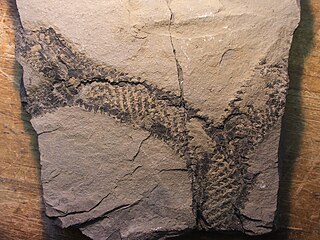
Lepidodendrales or arborescent lycophytes are an extinct order of primitive, vascular, heterosporous, arborescent (tree-like) plants belonging to Lycopodiopsida. Members of Lepidodendrales are the best understood of the fossil lycopsids due to the vast diversity of Lepidodendrales specimens and the diversity in which they were preserved; the extensive distribution of Lepidodendrales specimens as well as their well-preservedness lends paleobotanists exceptionally detailed knowledge of the coal-swamp giants’ reproductive biology, vegetative development, and role in their paleoecosystem. The defining characteristics of the Lepidodendrales are their secondary xylem, extensive periderm development, three-zoned cortex, rootlike appendages known as stigmarian rootlets arranged in a spiralling pattern, and megasporangium each containing a single functional megaspore that germinates inside the sporangium. Many of these different plant organs have been assigned both generic and specific names as relatively few have been found organically attached to each other. Some specimens have been discovered which indicate heights of 40 and even 50 meters and diameters of over 2 meters at the base. The massive trunks of some species branched profusely, producing large crowns of leafy twigs; though some leaves were up to 1 meter long, most were much shorter, and when leaves dropped from branches their conspicuous leaf bases remained on the surface of branches. Strobili could be found at the tips of distal branches or in an area at the top of the main trunk. The underground organs of Lepidodendrales typically consisted of dichotomizing axes bearing helically arranged, lateral appendages serving an equivalent function to roots. Sometimes called "giant club mosses", they are believed to be more closely related to extant quillworts based on xylem, although fossil specimens of extinct Selaginellales from the Late Carboniferous also had secondary xylem.

Quasipetalichthys haikouensis is the type and only known species of the extinct petalichthid placoderm, Quasipetalichthys. Fossil remains of Quasipetalichthys have been found in the Middle Devonian, Givetian faunal stage of China.

Pertica is a genus of extinct vascular plants of the Early to Middle Devonian. It has been placed in the "trimerophytes", a strongly paraphyletic group of early members of the lineage leading to modern ferns and seed plants.

The Medullosales is an extinct order of pteridospermous seed plants characterised by large ovules with circular cross-section and a vascularised nucellus, complex pollen-organs, stems and rachides with a dissected stele, and frond-like leaves. Their nearest still-living relatives are the cycads.
Bitelaria is a monospecific genus of extinct vascular plants described from outcrops of the Early Devonian Campbellton Formation in New Brunswick, Canada and Middle Devonian outcrops in the Voronezh region of Russia. B. dubjanski is characterized by thick-walled, dichotomously branched tubular axes and thick cuticles with possible lenticel-like eruptions. The unusual external morphology of the plant distinguishes it from other vascular plants and is thus placed in Tracheophyta incertae sedis.
Hicklingia is a genus of extinct plants of the Middle Devonian. Compressed specimens were first described in 1923 from the Old Red Sandstone of Scotland. Initially the genus was placed in the "rhyniophytes", but this group is defined as having terminal sporangia, and later work showed that the sporangia of Hicklingia were lateral rather than strictly terminal, so that it is now regarded as having affinities with the zosterophylls.
Yarravia is a genus of extinct vascular plants mainly known from fossils found in Victoria, Australia. Originally the rocks in which they were found were considered to be late Silurian in age; more recently they have been found to be Early Devonian. Specimens consist only of incomplete leafless stems, some of which bore groups of spore-forming organs or sporangia which were fused, at least at the base.
The barinophytes are a group of extinct vascular plants (tracheophytes). Their relationship with other vascular plants is unclear. They have been treated as the separate class Barinophytopsida, the order Barinophytales of uncertain class and as a family or clade Barinophytaceae within the zosterophylls. They have also been considered to be possible lycopodiopsids.
















